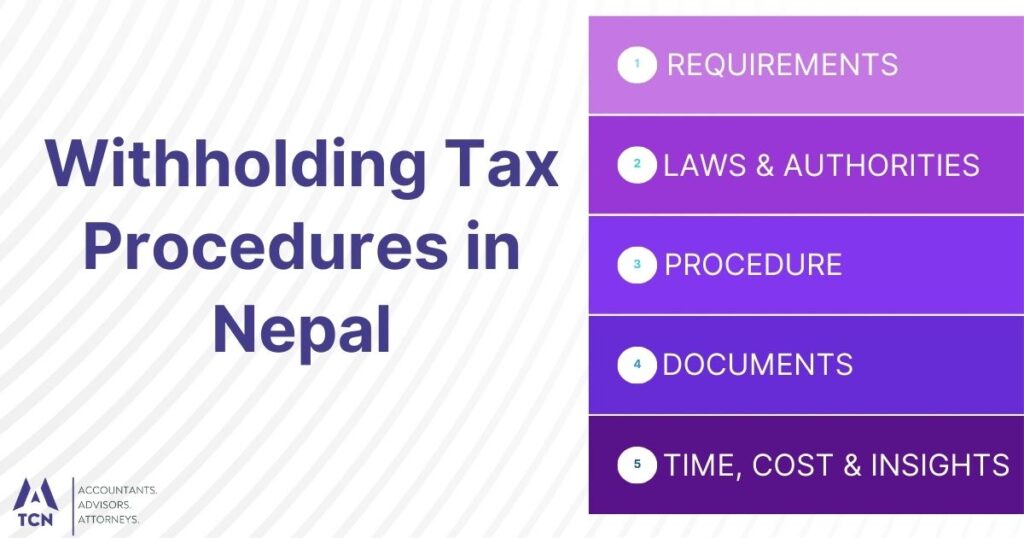Withholding tax is an important part of Nepal’s tax system that affects many individuals and businesses. This guide will walk you through the key aspects of withholding tax procedures in Nepal, from understanding what it is to calculating and reporting it properly. Whether you’re an employer, employee, or business owner, this information will help you navigate withholding tax requirements with confidence.
What is Withholding Tax in Nepal?
Withholding tax in Nepal is a method of collecting income tax at the source, where the payer deducts a certain percentage of tax from payments made to recipients. This system ensures that the government receives tax revenue promptly and regularly, rather than waiting for annual tax filings.
In Nepal, withholding tax applies to various types of income, including salaries, dividends, interest, and payments for goods and services. The concept is simple: instead of the recipient paying their entire tax bill at the end of the year, a portion is “withheld” each time they receive a payment.
This system benefits both the government and taxpayers. For the government, it provides a steady stream of tax revenue throughout the year. For taxpayers, it helps spread out their tax liability, making it easier to manage their finances.
Who is Responsible for Withholding Tax?
The responsibility for withholding tax in Nepal falls primarily on the payer of income. This includes:
- Employers paying salaries to employees
- Companies paying dividends to shareholders
- Banks paying interest to account holders
- Businesses making payments to contractors or service providers
As a payer, you are required to calculate the correct amount of tax, deduct it from the payment, and remit it to the Inland Revenue Department (IRD) of Nepal. This makes you a crucial link in the tax collection process.
It’s important to note that while the payer is responsible for withholding and remitting the tax, the ultimate tax liability still rests with the recipient of the income. The withholding tax is essentially a prepayment of the recipient’s annual income tax.
What are the Withholding Tax Rates?
Withholding tax rates in Nepal vary depending on the type of income and the status of the recipient. Here are some common withholding tax rates:
- Employment income: Progressive rates from 1% to 36%
- Dividends: 5% for resident individuals, 5% for resident companies
- Interest: 5% for resident individuals, 15% for non-residents
- Contract payments: 1.5% for residents, 5% for non-residents
- Rent: 10% for both residents and non-residents
- Service fees: 15% for non-residents
These rates are subject to change, so it’s crucial to stay updated with the latest tax regulations. The Nepal Inland Revenue Department regularly publishes updates on tax rates and procedures.
How to Report Withheld Taxes?
Reporting withheld taxes in Nepal involves several steps to ensure compliance with tax regulations:
- Maintain accurate records: Keep detailed records of all payments made and taxes withheld.
- Use the correct forms: The IRD provides specific forms for reporting withheld taxes. For example, use Form 87 for TDS (Tax Deducted at Source) returns.
- File monthly returns: Submit TDS returns to the IRD on a monthly basis, typically within 25 days of the end of each month.
- Provide annual statements: Issue TDS certificates to recipients annually, detailing the total payments made and taxes withheld.
- Reconcile accounts: Ensure that the total taxes reported match the amounts actually withheld and remitted to the IRD.
By following these steps, you’ll maintain compliance and avoid potential penalties for misreporting or late filing.
Relevant Articles:
- Share Registry Process in Nepal
- How to Apply for a Tax Identification Number (TIN) in Nepal
- E-TDS Registration in Nepal
When Should Withholding Tax be Paid?
Timely payment of withholding tax is crucial to avoid penalties and interest charges. In Nepal, the general rule is:
- Withholding tax must be paid within 25 days of the end of the month in which the deduction was made.
For example, if you withheld tax from payments made in Shrawan (mid-July to mid-August), you would need to remit those taxes to the IRD by the 25th of Bhadra (around September 10th).
It’s important to note that this deadline applies regardless of the amount withheld. Even if the withheld amount is small, you must still remit it on time to avoid penalties.
What Income is Subject to Withholding Tax?
In Nepal, a wide range of income types are subject to withholding tax. Understanding what income falls under this requirement is crucial for both payers and recipients. Here’s a list of common income types subject to withholding tax:
- Salaries and wages
- Bonuses and commissions
- Dividends from shares
- Interest on deposits and loans
- Rent from property
- Royalties
- Service fees
- Contract payments
- Insurance commissions
This list is not exhaustive, and there may be other types of income subject to withholding tax depending on specific circumstances. Always consult the latest IRD guidelines or a tax professional if you’re unsure about a particular type of income.
How to Obtain Withholding Tax Certificates?
Withholding tax certificates are important documents that prove taxes have been withheld from payments. Here’s how to obtain them:
- For recipients: Request a withholding tax certificate from the payer who deducted the tax.
- For payers: Generate withholding tax certificates for each recipient using the IRD’s prescribed format.
- Include all necessary details: The certificate should show the recipient’s name, PAN, amount paid, tax rate, and amount withheld.
- Issue certificates annually: Provide these certificates to recipients at the end of each fiscal year.
- Keep copies: Maintain records of all certificates issued for your own tax filing purposes.
These certificates are crucial for recipients when filing their annual tax returns, as they provide evidence of taxes already paid through withholding.


